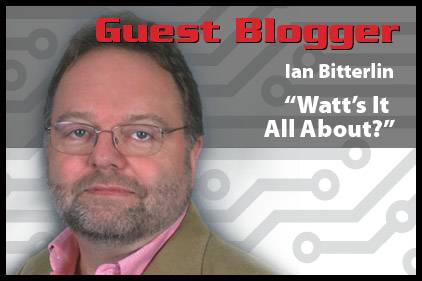It also ignores the fact that a growing number of UPS are line-interactive and actually don’t convert the supply to DC and back-again! Of course the debate is now centred around High Voltage DC (HVDC) because we can’t use LV (e.g. like -48VDC in telecom) due to the high currents (and loads of copper) associated with the high power found in data-centres. By ‘high’ we are talking about the range 380-600V DC. Anyway, soon, in March, The Green Grid is meeting to debate the AC/DC issue and I hope that someone will be there to speak up for Europe since we have a different perspective on HVDC, and here is why:
There is no doubt that the North American legacy practice of 460V/208V UPS that has isolation transformers front and back with 3-wire distribution to a 208/120V PDU transformer feeding 120V 1ph servers is very inefficient – typically <87% from MV facility input to load input as a maximum, really poor partial load efficiency and low SMPS (Switched Mode Power Supply) efficiency in the 120V IT load. On the other hand there are good arguments that it is a very robust and, particularly in the presence of harmonics, a very stable power platform with good earth/grounding and low Neutral-Earth voltages. So if someone in the USA wanted to do some research into energy saving no one should be surprised.
A few years back Lawrence Berkley National Labs (LBNL) did exactly that. However they decided to test a new pared-down 380V DC system with a legacy 460/208/120V AC system. The UPS was not new even then and was a prime example of worst-practice. Not surprisingly they came to a conclusion that you could save a lot of energy if ‘you’ (USA) switched to HVDC.
However, following the European solution might have been a better, or third, option: 400/400V UPS, 4-wire distribution, transformer-less UPS and PDU and 230V servers – along now with a wide acceptance of line-interactive topology and a growing interest in eco-mode. Even double-conversion UPS in Europe (from American OEMs!) gets you to 96% efficiency and well over 92% at 40% load (although the same OEMs don’t try to sell it in USA!). Unfortunately they didn’t test the third option – the European transformer-less 4-wire. IF they had done that they would have reached the interesting conclusion that we in Europe had already achieved the same energy saving without going away from AC.
OK, for each geography/region, there are code/regulation/standards issues, safety stuff (if you have ever worked with HVDC you will appreciate the arcing-display with disconnection), the idea of IT technicians getting arc-blindness etc etc – but all those practical are nothing that couldn’t be got around if HVDC was in fact more energy efficient. For ‘us’, in EMEA, the saving in energy is within 1% for dual-bus (Tier IV) and it is actually less efficient for single-bus (Tier III, active/passive path).
That brings up one important point; ALL HVDC systems will have to be dual-bus 2N even if you want Tier II or Tier III, just think about the ‘UPS’ bypass; with AC you can put the load onto the genset or the utility – something you cant do with HVDC unless you have the second active bus and that means that you have to have two DC power plants. Another point that has always bothered me is the ‘fiddle’ that LBNL used to demo the higher HVDC efficiency: They (very correctly) used 2N dual-bus but one path was just a rectifier without any energy storage and the other path had a single flywheel with a fixed DC output. Flywheels are less popular than batteries (and with two OEMs gone bust due to lack of sales and another losing $20M/year for the past few years) and probably not ‘growing’ in popularity) so if you put battery support onto both of the two buses you need a DC:DC regulator to cope with the +10%-20% battery voltage (float to deep-discharge) – so the losses increase! If the DC version of the server can accept +10-20% then why don’t the AC versions do the same?
I think that the covers most concerns in EMEA but behind it all is our big problem; all the ICT vendors are US/Asia based and we don’t have any in Europe so we often we have to ‘follow’ what our American cousins give us – and in this case, if we follow a change to HVDC, we go backwards.


Recent Comments
Enterprise Patch Management Policy
Hi Mr. Douglas, I really enjoyed this post....
IT management Support and Services
Modular construction discussion is very important for professional...
Good summary with a couple of questions: At...